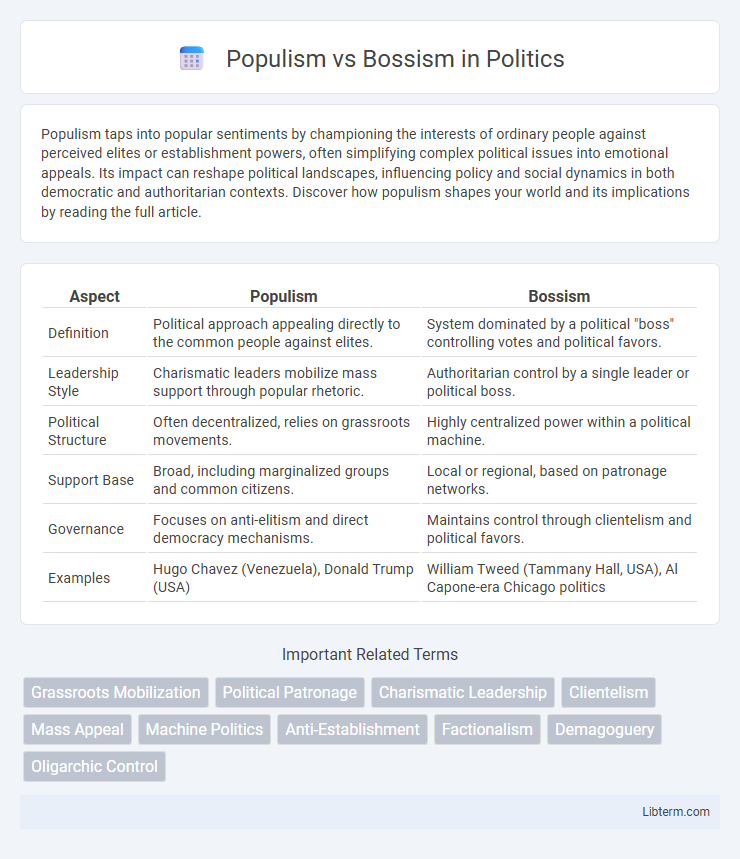Populism taps into popular sentiments by championing the interests of ordinary people against perceived elites or establishment powers, often simplifying complex political issues into emotional appeals. Its impact can reshape political landscapes, influencing policy and social dynamics in both democratic and authoritarian contexts. Discover how populism shapes your world and its implications by reading the full article.
Table of Comparison
| Aspect | Populism | Bossism |
|---|---|---|
| Definition | Political approach appealing directly to the common people against elites. | System dominated by a political "boss" controlling votes and political favors. |
| Leadership Style | Charismatic leaders mobilize mass support through popular rhetoric. | Authoritarian control by a single leader or political boss. |
| Political Structure | Often decentralized, relies on grassroots movements. | Highly centralized power within a political machine. |
| Support Base | Broad, including marginalized groups and common citizens. | Local or regional, based on patronage networks. |
| Governance | Focuses on anti-elitism and direct democracy mechanisms. | Maintains control through clientelism and political favors. |
| Examples | Hugo Chavez (Venezuela), Donald Trump (USA) | William Tweed (Tammany Hall, USA), Al Capone-era Chicago politics |
Understanding Populism: Definition and Key Features
Populism is a political ideology emphasizing the divide between the "common people" and the "elite," advocating for the rights and power of ordinary citizens against established institutions. Key features include charismatic leadership, anti-establishment rhetoric, and policies aimed at addressing popular grievances and social inequalities. Populism often mobilizes mass support through direct communication and emotional appeal, contrasting with bossism's focus on centralized control and patronage within political machines.
Bossism Explained: Origins and Characteristics
Bossism originated in the late 19th and early 20th centuries as a political system dominated by powerful party bosses who controlled urban political machines. Key characteristics include centralized authority, patronage networks, and the ability to mobilize votes through favors and political appointments. This system often emphasized pragmatic governance and loyalty over ideology, contrasting with populism's appeal to widespread popular grievances and anti-elite sentiment.
Historical Context: Populism vs Bossism
Populism emerged in the late 19th century as a political movement advocating for farmers and laborers against economic elites, emphasizing direct appeal to the masses and reforms like the Omaha Platform of 1892. Bossism, prominent in urban American politics during the same era, centered on political machines led by figures such as Boss Tweed in New York City, who wielded power through patronage, voter mobilization, and occasional corruption. The historical context of both reveals contrasting approaches: populism championed grassroots democracy and reform, while bossism maintained hierarchical control within political parties to dominate urban governance.
Leadership Styles: Populist Leaders vs Party Bosses
Populist leaders emphasize direct appeal to the masses, often leveraging charismatic authority and simplified messaging to mobilize popular support outside traditional political structures. Party bosses exert control through centralized power within political machines, relying on patronage networks, loyalty, and behind-the-scenes decision-making to maintain influence. The leadership style of populist leaders fosters broad public engagement and emotional connection, whereas party bosses prioritize organizational discipline and hierarchical control.
Power Dynamics: Grassroots vs Top-Down Control
Populism emphasizes grassroots power dynamics, mobilizing ordinary people to challenge established elites and advocate for collective interests, often fostering participatory democracy. Bossism features top-down control, where a political boss wields centralized authority, maintains loyalty through patronage, and limits grassroots input to consolidate power. The contrasting power structures highlight populism's bottom-up approach versus bossism's hierarchical, controlled governance.
Impact on Democracy: Populism and Bossism Compared
Populism often mobilizes mass support by appealing directly to popular grievances, which can enhance democratic participation but risks undermining institutional checks and balances. Bossism relies on centralized control through political machines and patronage systems, frequently leading to corruption and diminished accountability within democratic governance. Both phenomena challenge democratic norms, yet populism tends to reshape political agendas, while bossism erodes procedural integrity.
Social and Political Movements: Cases and Examples
Populism is characterized by movements that mobilize ordinary people against perceived elite domination, as seen in the rise of leaders like Hugo Chavez in Venezuela, who harnessed popular discontent to implement widespread social reforms. Bossism, meanwhile, refers to political systems dominated by a single powerful leader or "boss," such as New York's Tammany Hall under William M. Tweed, where political machines controlled votes through patronage and corruption. Both phenomena illustrate how social and political movements can shape governance, with populism emphasizing mass participation and anti-elitism, while bossism often relies on centralized, authoritarian control within party structures.
Media Influence: Shaping Populist and Bossist Narratives
Media influence plays a critical role in shaping both populist and bossist narratives by amplifying emotional appeals and simplifying complex policies for mass consumption. Populist movements leverage social media platforms to mobilize grassroots support and frame elites as oppressors, while bossism relies on traditional media networks to reinforce loyalty through patronage and controlled messaging. The strategic use of media enables populist leaders to foster direct engagement, whereas bossist figures manipulate media channels to sustain hierarchical political machines.
Criticisms and Controversies: Dangers of Both Approaches
Populism and Bossism face criticism for undermining democratic institutions by concentrating power in the hands of charismatic leaders or political bosses, which often leads to authoritarian tendencies and weakens checks and balances. Both approaches risk promoting corruption, clientelism, and erosion of rule of law, as their appeal to popular or localized interests can disregard broader democratic principles and minority rights. The dangers of populism and bossism manifest in political instability and manipulation of public opinion, ultimately threatening governance transparency and accountability.
Future Trends: The Evolving Battle Between Populism and Bossism
Future trends indicate an intensifying battle between populism and bossism as political landscapes evolve with digital media influence and increased public demand for accountability. Populism leverages grassroots mobilization and social media to challenge traditional bossism, which relies on hierarchical, centralized control and patronage networks. The dynamic interplay between these forces will shape governance models, political engagement, and policy-making strategies globally in the coming decade.
Populism Infographic

 libterm.com
libterm.com